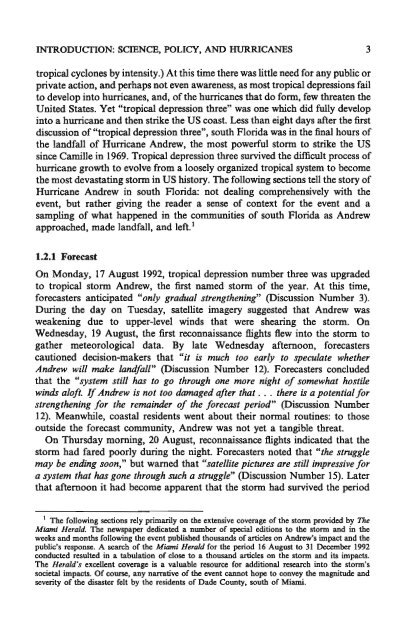Hurricanes: Their Nature and Impacts on Society - Climate Science ...
Hurricanes: Their Nature and Impacts on Society - Climate Science ...
Hurricanes: Their Nature and Impacts on Society - Climate Science ...
Create successful ePaper yourself
Turn your PDF publications into a flip-book with our unique Google optimized e-Paper software.
INTRODUCfION: SCIENCE, POLICY, AND HURRICANES<br />
tropical cycl<strong>on</strong>es by intensity.) At this time there was little need for any public or<br />
private acti<strong>on</strong>, <str<strong>on</strong>g>and</str<strong>on</strong>g> perhaps not even awareness, as most tropical depressi<strong>on</strong>s fail<br />
to develop into hurricanes, <str<strong>on</strong>g>and</str<strong>on</strong>g>, of the hurricanes that do form, few threaten the<br />
United States. Yet "tropical depressi<strong>on</strong> three" was <strong>on</strong>e which did fully develop<br />
into a hurricane <str<strong>on</strong>g>and</str<strong>on</strong>g> then strike the US coast. Less than eight days after the first<br />
discussi<strong>on</strong> of "tropical depressi<strong>on</strong> three", south Florida was in the final hours of<br />
the l<str<strong>on</strong>g>and</str<strong>on</strong>g>fall of Hurricane Andrew, the most powerful storm to strike the US<br />
since Camille in 1969. Tropical depressi<strong>on</strong> three survived the difficult process of<br />
hurricane growth to evolve from a loosely organized tropical system to become<br />
the most devastating storm in US history. The following secti<strong>on</strong>s tell the story of<br />
Hurricane Andrew in south Florida: not dealing comprehensively with the<br />
event, but rather giving the reader a sense of c<strong>on</strong>text for the event <str<strong>on</strong>g>and</str<strong>on</strong>g> a<br />
sampling of what happened in the communities of south Florida as Andrew<br />
approached, made l<str<strong>on</strong>g>and</str<strong>on</strong>g>fall, <str<strong>on</strong>g>and</str<strong>on</strong>g> left.!<br />
1.2.1 Forecast<br />
On M<strong>on</strong>day, 17 August 1992, tropical depressi<strong>on</strong> number three was upgraded<br />
to tropical st<strong>on</strong>n Andrew, the first named st<strong>on</strong>n of the year. At this time,<br />
forecasters anticipated "<strong>on</strong>ly gradual strengthening" (Discussi<strong>on</strong> Number 3).<br />
During the day <strong>on</strong> Tuesday, satellite imagery suggested that Andrew was<br />
weakening due to upper-level winds that were shearing the st<strong>on</strong>n. On<br />
Wednesday, 19 August, the first rec<strong>on</strong>naissance flights flew into the st<strong>on</strong>n to<br />
gather meteorological data. By late Wednesday afterno<strong>on</strong>, forecasters<br />
cauti<strong>on</strong>ed decisi<strong>on</strong>-makers that "it is much too early to speculate whether<br />
Andrew will make l<str<strong>on</strong>g>and</str<strong>on</strong>g>fall" (Discussi<strong>on</strong> Number 12). Forecasters c<strong>on</strong>cluded<br />
that the "system still has to go through <strong>on</strong>e more night of somewhat hostile<br />
winds aloft. If Andrew is not too damaged after that. ..there is a potential for<br />
strengthening for the remainder of the forecast period" (Discussi<strong>on</strong> Number<br />
12). Meanwhile, coastal residents went about their n<strong>on</strong>nal routines: to those<br />
outside the forecast community, Andrew was not yet a tangible threat.<br />
On Thursday morning, 20 August, rec<strong>on</strong>naissance flights indicated that the<br />
st<strong>on</strong>n had fared poorly during the night. Forecasters noted that "the struggle<br />
may be ending so<strong>on</strong>," but warned that "satellite pictures are still impressive for<br />
a system that has g<strong>on</strong>e through such a struggle" (Discussi<strong>on</strong> Number 15). Later<br />
that afterno<strong>on</strong> it had become apparent that the st<strong>on</strong>n had survived the period<br />
1 The following secti<strong>on</strong>s rely primarily <strong>on</strong> the extensive coverage of the storm provided by The<br />
Miami Herald. The newspaper dedicated a number of special editi<strong>on</strong>s to the storm <str<strong>on</strong>g>and</str<strong>on</strong>g> in the<br />
weeks <str<strong>on</strong>g>and</str<strong>on</strong>g> m<strong>on</strong>ths following the event published thous<str<strong>on</strong>g>and</str<strong>on</strong>g>s of articles <strong>on</strong> Andrew's impact <str<strong>on</strong>g>and</str<strong>on</strong>g> the<br />
public's resp<strong>on</strong>se. A search of the Miami Herald for the period 16 August to 31 December 1992<br />
c<strong>on</strong>ducted resulted in a tabulati<strong>on</strong> of close to a thous<str<strong>on</strong>g>and</str<strong>on</strong>g> articles <strong>on</strong> the storm <str<strong>on</strong>g>and</str<strong>on</strong>g> its impacts.<br />
The Herald's excellent coverage is a valuable resource for additi<strong>on</strong>al research into the storm's<br />
societal impacts. Of course, any narrative of the event cannot hope to c<strong>on</strong>vey the magnitude <str<strong>on</strong>g>and</str<strong>on</strong>g><br />
severity of the disaster felt by the residents of Dade County, south of Miami.<br />
3














